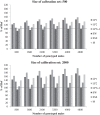Efficiency of genomic selection in an established commercial layer breeding program
- PMID: 23902427
- PMCID: PMC3750290
- DOI: 10.1186/1297-9686-45-29
Efficiency of genomic selection in an established commercial layer breeding program
Abstract
Background: In breeding programs for layers, selection of hens and cocks is based on recording phenotypic data from hens in different housing systems. Genomic information can provide additional information for selection and/or allow for a strong reduction in the generation interval. In this study, a typical conventional layer breeding program using a four-line cross was modeled and the expected genetic progress was derived deterministically with the software ZPLAN+. This non-genomic reference scenario was compared to two genomic breeding programs to determine the best strategy for implementing genomic information in layer breeding programs.
Results: In scenario I, genomic information was used in addition to all other information available in the conventional breeding program, so the generation interval was the same as in the reference scenario, i.e. 14.5 months. Here, we assumed that either only young cocks or young cocks and hens were genotyped as selection candidates. In scenario II, we assumed that breeders of both sexes were used at the biologically earliest possible age, so that at the time of selection only performance data of the parent generation and genomic information of the selection candidates were available. In this case, the generation interval was reduced to eight months. In both scenarios, the number of genotyped male selection candidates was varied between 800 and 4800 males and two sizes of the calibration set (500 or 2000 animals) were considered. All genomic scenarios increased the expected genetic gain and the economic profit of the breeding program. In scenario II, the increase was much more pronounced and even in the most conservative implementation led to a 60% improvement in genetic gain and economic profit. This increase was in all cases associated with higher breeding costs.
Conclusions: While genomic selection is shown to have the potential to improve genetic gain in layer breeding programs, its implementation remains a business decision of the breeding company; the possible extra profit for the breeding company depends on whether the customers of breeding stock are willing to pay more for improved genetic quality.
Figures





References
-
- Loberg A, Dürr JW. Interbull survey on the use of genomic information. Interbull Bull. 2009;39:3–14.
-
- Dekkers JCM, Stricker C, Fernando RL, Garrick DJ, Lamont SJ, O´Sullivan NP, Fulton JE, Arango J, Settar P, Kranis A, McKay J, Watson KA, Koerhuis A, Preisinger R. Implementation of genomic selection in egg layer chickens. J Anim Sci. 2010;87(E Suppl 2):6. http://www.jtmtg.org/2009/abstracts/Late-Breaking.pdf.
Publication types
MeSH terms
LinkOut - more resources
Full Text Sources
Other Literature Sources

